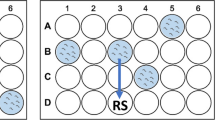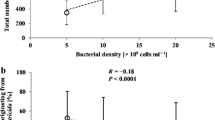Abstract
The entomopathogenic nematode–bacteria complexes Heterorhabditis bacteriophora/Photorhabdus luminescens and Steinernema carpocapsae/Xenorhabdus nematophila are mass produced for use as biological insecticides. Stability of the bacterial partner in culture is essential for maintaining traits important for both biological control and production. Two geographically distinct strains of each bacterial species were isolated from their nematode partners and serially subcultured on in vitro media to assess trait stability. Subculturing resulted in a shift to secondary cell production in one P. luminescens strain and both X. nematophila strains within ten in vitro culture cycles. However, when cell phenotypic variation was controlled in X. nematophila strains by regular selection for primary variants, no trait change was detected in the primary variant after prolonged subculture. When P. luminescens cell phenotypic variation was controlled by selection for primary variants, changes in the primary variant of both strains were noted including reductions in cell and inclusion body size and inclusion body prevalence. Bacterial ability to cause lethal infections following injection into the hemocoel of Tenebrio molitor larvae declined by more than half in primary variants of one P. luminescens strain. Conversely, yield was enhanced, with the subcultured P. luminescens strains showing 53.5 and 75.8% increases in primary cell density. Field adapted traits of primary variant P. luminescens strains tend to deteriorate during in vitro culture as tradeoffs for gains in yield. In vitro producers of the P. luminescens/H. bacteriophora complex must weigh the need for superior bacterial yield against the need to preserve traits important for biological control.






Similar content being viewed by others
References
Akhurst RJ (1980) Morphological and functional dimorphism in Xenorhabdus spp., bacteria symbiotically associated with insect pathogenic nematodes Neoaplectana and Heterorhabditis. J Gen Microbiol 121:303–309
Akhurst RJ (1982) Antibiotic activity of Xenorhabdus spp., bacteria symbiotically associated with insect pathogenic nematodes of the families Heterorhabditidae and Steinernematidae. J Gen Microbiol 128:3061–3065
Ancel LM, Bull JJ (2002) Fighting with change: adaptive variation in an uncertain world. Ecol Evol 17:551–557
Bai C, Shapiro-Ilan D, Wang Y, Gaugler R, Cowles E, Yi S (2006) Protein changes in the symbiotic bacterium Photorhabdus luminescens during in vitro serial culture. Intern J Nematol 15:126–135
Bedding RA, Akhurst R (1975) A simple technique for the detection of insect parasitic rhabditid nematodes in soil. Nematologica 21:109–110
Bell GC (1997) Selection. The mechanism of evolution. Chapman & Hall, London
Bilgrami AL, Gaugler R, Shapiro-Ilan D, Adams B (2006) Source of trait deterioration in entomopathogenic nematodes Heterorhabditis bacteriophora and Steinernema carpocapsae during in vivo culture. Nematology (in press)
Bintrim SB, Ensign JC (1998) Insertional inactivation of genes encoding the crystalline inclusion proteins of Photorhabdus luminescens results in mutants with pleiotrophic phenotypes. J Bacteriol 180:1261–1269
Bowen DJ, Ensign JC (2001) Isolation and characterization of protein inclusions produced by the entomopathogenic bacterium Photorhabdus luminescens. Appl Environ Microbiol 67:4834–4841
Couche GA, Gregson RP (1987) Protein inclusions produced by entomopathogenic bacterium Xenorhabdus nematophilus. J Bacteriol 169:5279–5288
DeBach P (1958) Selective breeding to improve adaptations of parasitic insects. Proc Xth Intern Congr Entomol 4:759–768
Dunphy GB, Webster JM (1989) The monoxenic culture of Neoaplectana carpocapsae DD136 and Heterorhabditis heliothidis. Rev Nematol 12:113–123
Elena SF, Lenski RL (2003) Evolution experiments with microorganisms: the dynamics and genetic bases of adaptation. Nat Rev 4:457–469
Forst S, Clarke D (2002) Bacteria-nematode symbiosis. In: Gaugler R (ed) Entomopathogenic nematology. CAB International, Wallingford, pp 57–77
Gaugler R, Campbell JF, Maguire TR (1989) Selection for host-finding in Steinernema feltiae. J Invertebr Pathol 54:363–372
Gaugler R, Han R (2002) Production technology. In: Gaugler R (ed) Entomopathogenic nematology. CAB International, Wallingford, pp 289–310
Georgis R (2002) The Biosys Experiment: an Insider’s Perspective. In: Gaugler R (ed) Entomopathogenic nematology. CAB International, Wallingford, United Kingdom, pp 357–372
Gerritsen LJM, de Raay G, Smits PH (1992) Characterization of form variants of Xenorhabdus luminescens. Appl Environ Microbiol 58:1975–1979
Grewal P, Georgis R (1999) Entomopathogenic nematodes. In: Hall FR, Menn JJ (eds) Methods in biotechnology: biopesticides: use and delivery, vol 5. Humana Press, New Jersey, pp 271–299
Hall BG (1988) Adaptive evolution that requires multiple spontaneous mutations. I. Mutations involving an insertion sequence. Genetics 120:887–897
Hu K, Webster JM (1998) In vitro and in vivo characterization of a small-colony variant of the primary form of Photorhabdus luminescens MD (Enterobacteriaceae). Appl Environ Microbiol 64:3214–3219
Hurlbert RE, Xu J, Small CL (1989) Colonial and cellular polymorphism in Xenorhabdus luminescens. Appl Environ Microbiol 55:1136–1143
Lenski RE, Rose MR, Simpson MC, Tadler SC (1991) Long-term experimental evolution in Escherichia coli. I. Adaptation and divergence during 2000 generations. Am Nat 138:1315–1341
Modi RI, Lucio HC, Szonja PR, Robert BH, Julia A (1992) Genetic changes accompanying increased fitness in evolving populations of Escherichia coli. Genetics 130:241–249
Mittler JE, Lenski RE (1990) New data on excisions of mu from E. coli MS2 cast doubt on the directed mutation hypothesis. Nature 344:173–175
Poinar GO Jr, Thomas GM (1966) Significance of Achromobacter nematophilus Poinar and Thomas (Achromobacteraceae: Eubacteriales) in the development of the nematode, DD-136 (Neoaplectana sp., Steinernematidae). Parasitology 56:385–390
Poinar GO Jr, Thomas GM (1967) The nature of Achromobacter nematophilus as an insect pathogen. J Invertebr Pathol 9:510–514
Popiel I, Grove DL, Friedman MJ (1989) Infective juvenile formation in the insect parasitic nematode Steinernema feltiae. Parasitology 99:77–81
Reed LJ, Muench H (1938) A simple method of estimating fifty percent endpoints. Am J Hyg 27:493–497
Shapiro DI, Glazer I, Segal D (1996) Trait stability and fitness of the heat tolerant entomopathogenic nematode Heterorhabditis bacteriophora IS5 strain. Biol Control 6:238–244
Strauch O, Stoessel S, Ehlers RU (1994) Culture conditions define automictic or amphimictic reproduction in entomopathogenic rhabditid nematodes of the genus Heterorhabditis. Fund Appl Nematol 17:575–582
Stuart R, Gaugler R (1996) Genetic adaptation and founder effect in laboratory populations of the entomopathogenic nematode Steinernema glaseri. Can J Zool 74:164–170
Travisano M, Mongold JA, Bennett AF, Lenski RE (1995) Experimental tests of the roles of adaptation, chance, and history in evolution. Science 267:87–90
Wang X, Grewal PS (2002) Rapid genetic deterioration of environmental tolerance and reproductive potential of an entomopathogenic nematode during laboratory maintenance. Biol Control 23:71–78
Webster JM, Chen G, Hu K, Li J (2004) Bacterial metabolites. In: Gaugler R (eds) Entomopathogenic nematology. CAB International, Wallingford, pp 99–114
Woodring JL, Kaya HK (1988) Steinernematid and heterorhabditid nematodes: a handbook of biology and techniques. South Coop Ser Bull 331:1–30
You J, Liang S, Cao L, Liu X, Han R (2006) Nutritional significance of crystalline inclusion bodies of Photorhabdus luminescens in Steinernema nematodes. FEMS Microb Ecol 55:178–185
Acknowledgments
We thank C. Brey for comments and assistance. The project was supported by the National Research Initiative of the USDA Cooperative State Research, Education and Extension Service, grant number 2002-35316-12395.
Author information
Authors and Affiliations
Corresponding author
Rights and permissions
About this article
Cite this article
Wang, Y., Bilgrami, A.L., Shapiro-Ilan, D. et al. Stability of entomopathogenic bacteria, Xenorhabdus nematophila and Photorhabdus luminescens, during in vitro culture. J Ind Microbiol Biotechnol 34, 73–81 (2007). https://doi.org/10.1007/s10295-006-0166-4
Received:
Accepted:
Published:
Issue Date:
DOI: https://doi.org/10.1007/s10295-006-0166-4




